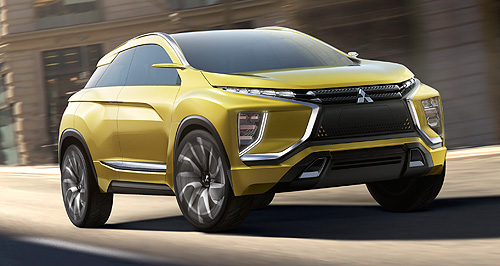Future models - Mitsubishi - eX ConceptTokyo show: Mitsubishi to debut eX ConcepteX communicated: Mitsubishi's Tokyo concept has car-to-car communication, and can find its own way out of a natural disaster as well as leading others to safety. All-electric eX Concept could preview Mitsubishi SUV for the compact segment9 Oct 2015 MITSUBISHI will outline the future of its electric vehicle technology, as well as the direction of its emerging Dynamic Shield design language, with a Tokyo show concept dubbed the eX. According to the Japanese car-maker, the all-electric shooting brake offers a glimpse at the evolution of its emerging Dynamic Shield design language, as well as the technology expected to debut in future Mitsubishi production models. Those advances include pure electric all-wheel drive transmission, autonomous driving tech, connected car systems and the latest in passive and active safety advancements. Mitsubishi Australia was unable to confirm if the concept had been drafted into any production development stages, but a long list of product information suggests the car is more than just a show pony. Measuring 4240mm long, 1780mm wide and 1575mm tall, the new vehicle appears to qualify as a crossover at the smaller end of the SUV range, and if a production version were to result, the model would make sense in the booming local compact segment. Mitsubishi has previously showcased a sporty XR PHEV concept that was confined to the virtual computer games arena. With a more practical focus, this latest concept is unlikely to be simply an evolution of the two-dimensional car. A showroom version would be more closely related to the XR PHEV II concept that surfaced in Geneva earlier this year, but GoAuto understands the eX is not merely a second outing of the XR. Shorter in length and lower in height than the ASX, a production version of the eX would fit more comfortably into a segment under the existing production car, rather than serving as a replacement for it. On the outside, the eX Concept's “more functional” styling features the latest version of Mitsubishi's ‘shield’ front end and suicide-opening rear doors that are unlikely to survive through to a production car. The design direction continues on the inside, with different colours for the driver and passenger seats to create an unusual but sporty and bright interior, while a frame structure dash is both light in appearance and in weight. An augmented reality heads-up display relays information to the driver via a windscreen-reflected display, while the central display keeps occupants entertained with connected car technology and an information network. A 70kW electric motor on each axle gives the eX a total of 140kW and, with lightweight construction, the EV can cover 400km on a single charge. Mitsubishi's S-AWC four-wheel-drive transmission and Active Yaw Control manages the torque split between front and rear drive, and three switchable modes allow the driver to negotiate different types of terrain. Auto mode uses a series of sensors to read the approaching terrain and set the S-AWC system to provide the best traction, Gravel is selected for low friction surfaces including unsealed and wet roads, and Snow provides the best grip on the slipperiest of surfaces. The eX's V2H compatibility allows a user to connect the vehicle's 45kWh lithium-ion battery to a household power network, which can provide up to four days of power to appliances says Mitsubishi. Like many manufacturers, Mitsubishi is also experimenting with autonomous driving technology in the concept including a Valet Parking function which allows the car to park itself after the occupants have alighted. The car is summoned back to the drop-off point via smartphone, having charged itself in a specially designated charge bay. In Cooperative Adaptive Cruise mode, the eX uses vehicle-to-vehicle to form a highway convoy, while an Automated Lane Change function uses information systems to avoid congestion or hazards. Its series of cameras and radar sensors help the vehicle to avoid obstacles and obstructions at both freeway speeds and in stop-start traffic. The system also provides information for the front and rear cross traffic alerts, blind-spot monitoring, self-parking with passengers aboard and a driver fatigue monitoring system that can tell if a driver is becoming drowsy. Connected car communication shares information with other compatible vehicles and can be used to avoid traffic, warn other road users of changing conditions or advise of a safe escape route following a natural disaster, for example.  Read moreAll future models Alfa Romeo Alfa Romeo Abarth Abarth Audi Audi Aston Martin Aston Martin BMW BMW Bentley Bentley Chrysler Chrysler Chevrolet Chevrolet Dodge Dodge Citroen Citroen Ferrari Ferrari DS DS Ford Ford Fiat Fiat FPV FPV Foton Foton Haval Haval Great Wall Great Wall Honda Honda Holden Holden Hyundai Hyundai HSV HSV Isuzu Isuzu Infiniti Infiniti Jeep Jeep Jaguar Jaguar Lamborghini Lamborghini Kia Kia Lexus Lexus Land Rover Land Rover Mazda Mazda Maserati Maserati Mercedes-Benz Mercedes-Benz McLaren McLaren Mini Mini Nissan Nissan Mitsubishi Mitsubishi Peugeot Peugeot Opel Opel Proton Proton Porsche Porsche Renault Renault Ram Ram Saab Saab Rolls-Royce Rolls-Royce Smart Smart Skoda Skoda Subaru Subaru SsangYong SsangYong Tesla Tesla Suzuki Suzuki Toyota Toyota Volvo VolvoMotor industry news |
Click to shareMitsubishi modelsResearch Mitsubishi All future models Alfa Romeo Alfa Romeo Abarth Abarth Audi Audi Aston Martin Aston Martin BMW BMW Bentley Bentley Chrysler Chrysler Chevrolet Chevrolet Dodge Dodge Citroen Citroen Ferrari Ferrari DS DS Ford Ford Fiat Fiat FPV FPV Foton Foton Haval Haval Great Wall Great Wall Honda Honda Holden Holden Hyundai Hyundai HSV HSV Isuzu Isuzu Infiniti Infiniti Jeep Jeep Jaguar Jaguar Lamborghini Lamborghini Kia Kia Lexus Lexus Land Rover Land Rover Mazda Mazda Maserati Maserati Mercedes-Benz Mercedes-Benz McLaren McLaren Mini Mini Nissan Nissan Mitsubishi Mitsubishi Peugeot Peugeot Opel Opel Proton Proton Porsche Porsche Renault Renault Ram Ram Saab Saab Rolls-Royce Rolls-Royce Smart Smart Skoda Skoda Subaru Subaru SsangYong SsangYong Tesla Tesla Suzuki Suzuki Toyota Toyota Volvo VolvoMotor industry news |



































Facebook Twitter Instagram